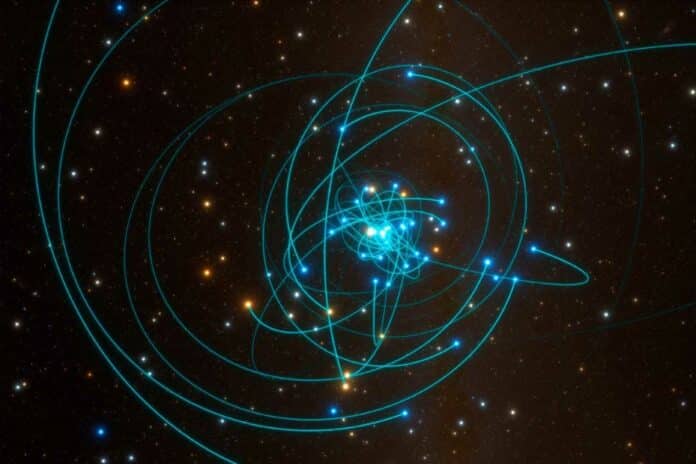Some ancient stars orbit the Milky Way’s black hole. Despite being old, these stars appear deceptively young for a darker reason: They consume their neighbors.
This is just one of the most unusual discoveries made by a recent study from Northwestern University. Astrophysicists used a novel model to track the violent journey of 1,000 simulated stars around Sagittarius A* (Sgr A*), the central supermassive black hole in our galaxy.
Because the region is so densely populated with stars, violent collisions frequently occur there. The new research, which simulates the impact of these violent collisions, discovers that stars that survive collisions can either merge with other stars to become enormous and renewed in appearance or lose mass and become stripped-down, low-mass stars.
The gravitational pull from the Sgr A* black hole makes stars move fast in their orbits around it. Millions of stars are crowded in the center of the galaxy, and with the fastest-moving stars, it’s like a crazy, high-speed race. Only a few stars—near the black hole, within a very short distance—manage to avoid getting pulled in or smashed up.
Northwestern‘s Sanaea C. Rose, who led the research, said, “The closest star to our sun is about four light-years away. Within that same distance, near the supermassive black hole, there are more than a million stars. It’s an incredibly crowded neighborhood. On top of that, the supermassive black hole has a powerful gravitational pull. Stars can move at thousands of kilometers per second as they orbit the black hole.”
There are moments when stars collide in this crowded location. These collisions become more likely closer to the massive black hole. Rose and her colleagues developed a computer program to simulate events in the galactic core because they were interested in what occurs when stars collide. This program takes into account numerous factors, including the stars’ density, mass, velocity, and separation from the black hole.
In her research, Rose discovered that a star’s fate is greatly influenced by its distance from the supermassive black hole.
Stars orbiting a black hole accelerate at thousands of kilometers per second, reaching 0.01 parsecs. They bump into one another all the time, although it’s more of an intense bump than a direct crash. These encounters will only partially destroy the stars. Instead, they continue their course after losing part of their outer layers, creating low-mass stars stripped of their outer layers.
Stars travel at slower velocities, hundreds of kilometers per second when they are farther away. Mergers occur when they collide, but they do so with less energy. Certain stars grow significantly larger—up to ten times larger than our sun, via repeated mergers.
“A few stars win the collision lottery,” Rose said. “Through collisions and mergers, these stars collect more hydrogen. Although they were formed from an older population, they masquerade as rejuvenated, young-looking stars. They are like zombie stars; they eat their neighbors.”
However, these massive stars have shorter lifespans because they quickly burn through their hydrogen fuel.
Rose likes exploring an unusual and extreme region close to our galaxy’s center. The study sheds light on this enigmatic area and the historical context for the Milky Way. The team uses simulations to reveal hidden processes because it is difficult to observe the central cluster directly.
“It’s an environment unlike any other,” Rose said. “Stars, which are under the influence of a supermassive black hole in a very crowded region, are unlike anything we will ever see in our solar neighborhood. But if we can learn about these stellar populations, then we might be able to learn something new about how the galactic center was assembled. At the very least, it certainly provides a point of contrast for the neighborhood where we live.”
Journal References:
- Sanaea C. Rose et al., Collisional Shaping of Nuclear Star Cluster Density Profiles, The Astrophysical Journal Letters (2024). DOI: 10.3847/2041-8213/ad251f
- Sanaea C. Rose et al., Stellar Collisions in the Galactic Center: Massive Stars, Collision Remnants, and Missing Red Giants, The Astrophysical Journal (2023). DOI: 10.3847/1538-4357/acee75
